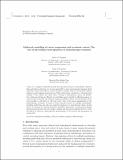Files in this item
Multiscale modelling of cancer progression and treatment control : the role of intracellular heterogeneities in chemotherapy treatment
Item metadata
| dc.contributor.author | Chaplain, Mark Andrew Joseph | |
| dc.contributor.author | Powathil, Gibin | |
| dc.date.accessioned | 2015-10-29T14:40:00Z | |
| dc.date.available | 2015-10-29T14:40:00Z | |
| dc.date.issued | 2015-06 | |
| dc.identifier | 212225808 | |
| dc.identifier | d53a2d7e-e70b-4ebd-9a0e-14d4daa15181 | |
| dc.identifier | 84938751521 | |
| dc.identifier.citation | Chaplain , M A J & Powathil , G 2015 , ' Multiscale modelling of cancer progression and treatment control : the role of intracellular heterogeneities in chemotherapy treatment ' , Biophysical Reviews and Letters , vol. 10 , no. 2 , pp. 97-114 . https://doi.org/10.1142/S1793048015500058 | en |
| dc.identifier.issn | 1793-0480 | |
| dc.identifier.other | ORCID: /0000-0001-5727-2160/work/55379015 | |
| dc.identifier.uri | https://hdl.handle.net/10023/7714 | |
| dc.description.abstract | Cancer is a complex, multiscale process involving interactions at intracellular, intercellular and tissue scales that are in turn susceptible to microenvironmental changes. Each individual cancer cell within a cancer cell mass is unique, with its own internal cellular pathways and biochemical interactions. These interactions contribute to the functional changes at the cellular and tissue scale, creating a heterogenous cancer cell population. Anticancer drugs are effective in controlling cancer growth by inflicting damage to various target molecules and thereby triggering multiple cellular and intracellular pathways, leading to cell death or cell-cycle arrest. One of the major impediments in the chemotherapy treatment of cancer is drug resistance driven by multiple mechanisms, including multi-drug and cell-cycle mediated resistance to chemotherapy drugs. In this article, we discuss two hybrid multiscale modelling approaches, incorporating multiple interactions involved in the sub-cellular, cellular and microenvironmental levels to study the effects of cell-cycle, phase-specific chemotherapy on the growth and progression of cancer cells. | |
| dc.format.extent | 1886905 | |
| dc.language.iso | eng | |
| dc.relation.ispartof | Biophysical Reviews and Letters | en |
| dc.subject | Multiscale modelling | en |
| dc.subject | Cell-cycle pathway | en |
| dc.subject | Hypoxia | en |
| dc.subject | Chemotherapy | en |
| dc.subject | RC0254 Neoplasms. Tumors. Oncology (including Cancer) | en |
| dc.subject | QH301 Biology | en |
| dc.subject | QA Mathematics | en |
| dc.subject | NDAS | en |
| dc.subject | SDG 3 - Good Health and Well-being | en |
| dc.subject.lcc | RC0254 | en |
| dc.subject.lcc | QH301 | en |
| dc.subject.lcc | QA | en |
| dc.title | Multiscale modelling of cancer progression and treatment control : the role of intracellular heterogeneities in chemotherapy treatment | en |
| dc.type | Journal article | en |
| dc.contributor.institution | University of St Andrews. Applied Mathematics | en |
| dc.identifier.doi | https://doi.org/10.1142/S1793048015500058 | |
| dc.description.status | Peer reviewed | en |
| dc.identifier.url | http://www.worldscientific.com/doi/abs/10.1142/S1793048015500058?src=recsys | en |
This item appears in the following Collection(s)
Items in the St Andrews Research Repository are protected by copyright, with all rights reserved, unless otherwise indicated.

